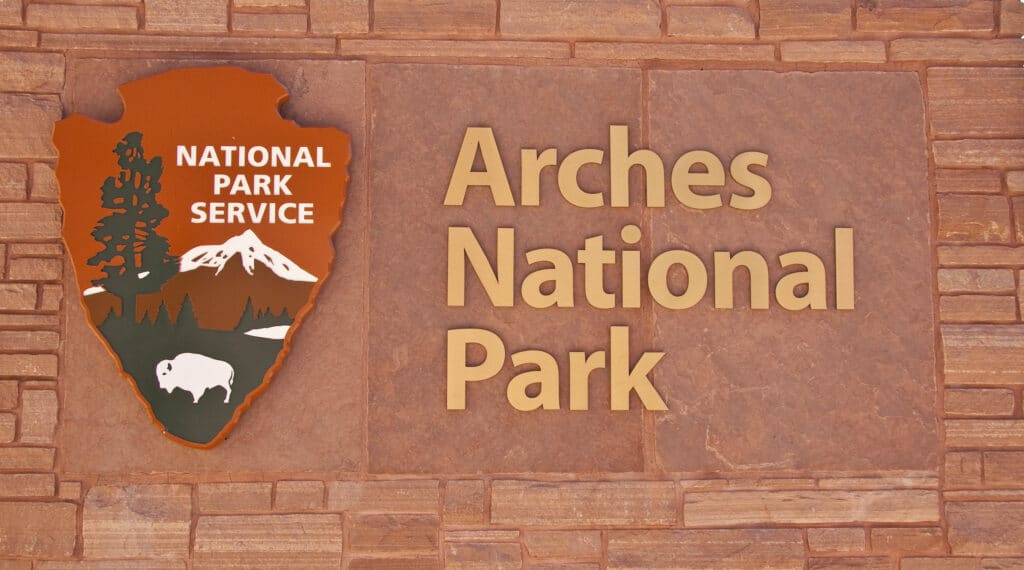
Arches National Park charges a standard entry fee that is valid for seven consecutive days. The current fees are $30 per vehicle, $25 per motorcycle, or $15 per individual entering on foot or bicycle (children 15 and under enter free). Frequent visitors can opt for the Southeast Utah Parks Annual Pass at $55, which covers Arches, Canyonlands, and nearby monuments for a year. The interagency America the Beautiful Pass ($80 yearly) is also accepted and is a great deal if you’re visiting multiple national parks (U.S. seniors, military members, veterans, 4th graders, and visitors with disabilities qualify for free or discounted versions of this pass).
The park is open 24 hours a day, year-round — you can even enter at night for stargazing or predawn hikes. Note that from April 1 to July 6 and August 28 to October 31, 2025, a timed-entry reservation is required to drive into Arches between 7:00 am and 4:00 pm (this reservation costs $2 and is needed in addition to the entrance fee). Outside those dates, or outside those peak hours, you can arrive without a reservation. The busiest season is spring through fall, so expect lines at the gate and crowded parking lots midday. To avoid congestion, we went at off-peak times as the park recommends. The visitor center near the entrance is open daily (generally 9:00 am to 4:00 pm, with extended hours in summer) except on Christmas Day, offering park maps, exhibits, and bathrooms. We visited on 14 July 2025, and all figures were valid then.
A Closer Look at the Park
Ever wonder how nature managed to carve over 2,000 stone arches in one place? The answer lies in Arches National Park’s unique geology and long history. The area was first set aside as a national monument in 1929 (later designated a national park in 1971) specifically to protect its extraordinary rock formations. Here, over millions of years, a thick underground salt bed buckled the earth’s surface, and water and ice eroded the fragile sandstone into fins, windows, and archways. The result is a landscape of red rock arches, spires, and massive balanced rocks that look like sculptures – it’s basically an open-air geology museum. One of these formations, the Delicate Arch, has even become an icon of Utah (you’ll spot its image on Utah license plates).
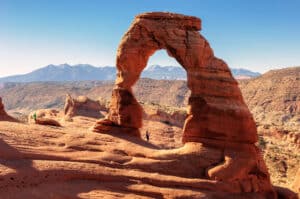
Delicate Arch, Arches National Park, Utah
The park spans about 76,500 acres of high desert on the Colorado Plateau, with elevations ranging roughly from 4,000 to 5,600 feet. In practical terms, that means hot summers and cold winters. Daytime temperatures in July can soar above 100°F (38°C), while winter days can drop below freezing at times. We came prepared for the dry desert climate – carrying plenty of water and wearing layers – and it paid off. The environment may look stark, but it supports a surprisingly rich ecosystem. Hardy plants like juniper trees, pinyon pines, sagebrush, prickly pear cactus, and yucca find niches in the red rocks. Underfoot, we saw black patches of cryptobiotic soil (a living crust of algae, fungi, and bacteria) which holds the sand in place; stepping off trail can damage this fragile crust, so we were careful to stay on marked paths. Animal life is present too, though many creatures hide from the daytime heat. Desert bighorn sheep roam the rocky hills (we spotted hoof prints and droppings, though the sheep themselves eluded us), and we caught glimpses of lizards darting across warm boulders. In the cooler hours around sunset, you might see mule deer or hear coyotes in the distance. Birdwatchers will also have fun – we noticed ravens soaring above the red cliffs, and smaller birds flitting among the shrubs. (Keep your snacks secure; ground squirrels and chipmunks in picnic areas will sneakily approach if you’re not looking, and feeding wildlife is a big no-no.)
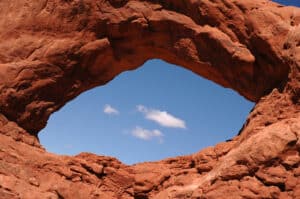
Cosmic Stone Eye
This park offers more than static scenery – it’s an outdoor playground for hikers and explorers. A paved scenic road winds 18 miles through Arches, leading to all the main sites, but we found the best experiences came when we parked the car and hit the trails. Our favorite hike was the trek to Delicate Arch, a 3-mile round trip that climbs a steep slickrock slope to the base of the most famous arch in the park. It’s a moderately strenous walk (bring water and sunhat), but standing under Delicate Arch in person – with its 46-foot tall span framing the sky – was unforgettable. Another great walk was the easy trail at Devils Garden to Landscape Arch, which is the longest arch in North America (imagine a rock span longer than a football field, impossibly thin in the middle). We also enjoyed shorter walks, like the loop around Balanced Rock (a giant boulder teetering on a slender pillar) and the short hikes in the Windows Section, where you can see multiple arches (North Window, South Window, and Double Arch) within a short distance. For more adventurous souls, the Fiery Furnace area offers a maze of narrow canyons to scramble through – we had to obtain a special permit (or you can join a ranger-guided tour) to explore that area due to its labyrinthine and fragile nature. With so many natural wonders, it’s no surprise that Arches draws over a million visitors each year.
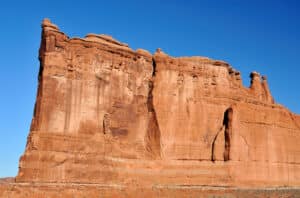
Tower of Babel, Arches National Park, Utah, USA.
Most visitors spend at least half a day here, but we recommend dedicating a full day if you can. We arrived early and stayed until nightfall to really soak it all in. In terms of timing, early morning and late afternoon are golden: not only is the heat less intense, but the low-angle sunlight makes the red rocks glow brilliantly. As evening came, we were treated to another delight – Arches has exceptional night skies. In 2019 it was certified as an International Dark Sky Park, and we definitely saw why. Once the sun set and the stars emerged, we lay back on a warm rock and gazed up at the Milky Way shimmering overhead. It’s an awe-inspiring sight that many urban visitors rarely get to experience. (If you stay after dark, carry a headlamp and watch your step on the way back – the terrain can be tricky at night.)
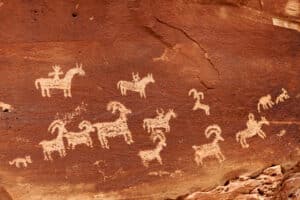
Ancient petroglyphs in Arches National Park,Utah,America
Nearby Attractions & Dining Spots
Our adventure didn’t end at the park boundary. The Moab area is an outdoor enthusiast’s paradise, so we took advantage of nearby sights and activities around Arches as well. Just outside the park, along the Colorado River, we found opportunities for rafting and kayaking – several local outfitters run half-day rafting trips through the scenic redrock canyons (we saw bright rafts bobbing downstream when we crossed the bridge north of Moab). If you’re into camping, Arches has the Devils Garden Campground at the far end of the scenic road, where we spent one night under a blanket of stars (note: it has limited sites and fills up fast, so reservations are needed). For those who prefer more amenities, the town of Moab (only 5 miles south of the park) offers plenty of lodging options from campsites to hotels.
Inside the park, there are a few must-see spots we haven’t mentioned yet that we really enjoyed:
-
Park Avenue Trail – a moderate one-mile trail between sheer sandstone walls that felt like walking down a grand natural boulevard. The towering rock formations (with names like “Courthouse Towers” and “Three Gossips”) left us speechless and gave us great photo ops.
-
Panorama Point – a pull-off on the scenic drive where we paused to take in a wide-angle view of the desert landscape. From there we could see distant snow-capped La Sal Mountains contrasting with the red rocks – a beautiful vista and a reminder that diverse terrain surrounds Arches.
-
Skyline Arch – a smaller arch perched high on a rock wall near Devils Garden. A short 5-minute stroll led us right below this arch, which had a huge chunk fall out in the 1940s (doubling its opening size). It was a quick but worthwhile stop, especially knowing we were seeing a formation still in the process of change.
-
Courthouse Wash Rock Art Panel – at the park’s entrance road we checked out a brief side trail to a rock face with ancient petroglyphs. Faint but visible, these petroglyphs (estimated to be a few hundred years old) gave us a glimpse into the human history of this region. It’s amazing to think people have been passing through and recording their stories here long before it became a park.
Outside the park, we also explored a few other nearby attractions. Dead Horse Point State Park, about a 30-minute drive from Arches, offered a breathtaking overlook of the Colorado River canyon (so dramatic that it’s been a filming location for movies). We went there in the late afternoon and saw a magnificent sunset over the canyon country. Another worthwhile side trip was Canyonlands National Park (Island in the Sky district), roughly 30 miles away. There, we stood atop sheer cliffs and looked out over a vast maze of canyons – a completely different but complementary experience to the close-up wonders of Arches. If you have time for a different kind of hike, just outside Arches on BLM land is the trail to Corona Arch (which we did on another day) – it’s a free hike to another impressive arch without the crowds, though a bit more rugged. The Moab area is also famous for mountain biking: we didn’t bike on this trip, but many travelers tackle the Slickrock Bike Trail or other routes in the nearby Sand Flats Recreation Area for a dose of two-wheeled adventure.
Of course, all that exploring made us hungry. Thankfully, Moab has no shortage of great food. We started one morning at Love Muffin Cafe, a local favorite where we grabbed coffee and breakfast burritos to-go (the perfect fuel before a long hike). In the evenings after our park adventures, we tried a couple of the town’s eateries. One night we had dinner at Moab Brewery, a casual spot where we enjoyed craft beer brewed on-site and bison burgers – a hearty meal after a day of trails. Another day we unwound at the classic Moab Diner, a no-frills 50’s style diner known for its green chile cheeseburger and thick milkshakes (we can confirm both hit the spot!). For a treat, we also stopped by Moab Coffee Roasters in the afternoon for an iced coffee and poked our heads into Moab Made, a little shop selling local art and souvenirs. It was nice to slow down, browse handmade pottery and jewelry, and reflect on the day’s adventures.
How can you beat the crowds and heat at Arches? In our experience, planning ahead and timing are key. We learned that entering the park early in the morning (before 7 am) let us snag parking at popular trailheads and hike in cooler conditions. Late afternoon is another good window, once some daytime visitors have left – we noticed trails like Delicate Arch became quieter by sunset. We’d also suggest avoiding holiday weekends if possible, since that’s when the park was the most crowded. And here’s another tip: carry more water than you think you need, wear sunscreen and a hat, and don’t underestimate the desert sun. We saw a few hikers turning back early because they ran out of water or got too hot. Also, dont forget a flashlight if you plan to stay for stargazing – it’s very dark (which is the whole point). With a little preparation, we found we could enjoy the park’s highlights at our own pace despite the popularity of this place.
Our journey through Arches National Park was both educational and exhilarating. We came for the famous arches but left with an appreciation for all the little details – the resilient plants, the silence of a remote trail, the glow of the Milky Way after moonrise. Arches impressed us not with loud fanfare but with the quiet, steady grandeur of nature’s work. It’s the kind of place that we’d eagerly recommend to any traveler interested in geology, hiking, or just experiencing a truly unique corner of the American Southwest. We left with memories (and yes, plenty of photos) that we’ll treasure, already thinking about what we’ll explore next time we visit.
Sorry, there were no items that matched your criteria.

